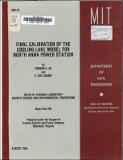| dc.contributor.author | Ho, Edmond K. | en_US |
| dc.contributor.author | Adams, E. Eric | en_US |
| dc.date.accessioned | 2022-06-13T13:11:39Z | |
| dc.date.available | 2022-06-13T13:11:39Z | |
| dc.date.issued | 1984-08 | |
| dc.identifier | 295 | |
| dc.identifier.uri | https://hdl.handle.net/1721.1/143039 | |
| dc.description | Prepared under the support of the Virginia Electric and Power Company. | en_US |
| dc.description.abstract | The North Anna Power Station is a two-unit power plant located on Lake Anna and operated by Virginia Electric and Power Company (VEPCO). A complex cooling lake system, involving a diked-off portion of Lake Anna - known as the Waste Heat Treatment Facility (WHTF) - as well as the main lake, was designed to dissipate the waste heat rejected by the plant. In order to monitor the impacts that the waste heat discharge has on the natural environment and also to assess the efficiency of the cooling lake system, a segmented mathematical model was previously developed (Jirka et al., 1977). Since Unit 1 of North Anna Power Station came on line in summer of 1978 (followed by Unit 2 in autumn of 1980), an extensive data collection network was established by VEPCO. The model was previously calibrated using data from the first three years of operational data (1978 to 1981, primarily one-unit operation). Since then more measurements were available and an independent validation was conducted by comparing model predictions with data for the following two years (1981 to 1983, with more two-unit operation) using the same model calibrations. Surface temperature error analysis was made for four representative diagnostic control points over the cooling lake system. It was noticed that the model results for five years were similar to those for the first three years. However, temperature rise across the plant condenser was consistently over-predicted by an average of about 0.70 �C over all five years. In addition, results of spectral analysis showed that the raw error at DIKE III was periodic at predominantly the annual frequency whereas the rest of the control points showed mild periodicities over a relatively wide range of frequencies. Model recalibration aiming at improving the goodness-of-fit of the five years of measurement data at DISCHARGE and DIKE III was motivated by the results of the surface temperature error analysis. Two possible reasons for the transient errors characterized by annual periodicity of the raw error at DIKE III were identified, namely, errors associated with (1) the forcing function (surface heat transfer) and (2) system response of the model. Two candidates for each of the possible reasons were considered: (la) atmospheric radiation, (1b) evaporation, (2a) spatially-averaged system response, and (2b) longitudinal system response. Regarding the steady state errors at DISCHARGE, a sensitivity analysis of the raw error with respect to changes in the plant operation data was made, and it was noticed that the mean raw error was reduced substantially by a moderate reduction of the waste heat discharged into the WHTF. In all, two changes of the model were made as a result of recalibration: computation of residence times in the WHTF and adjustment of plant operation data. The recalibrated model was validated by comparing predictions with five years (1978-1983) of measurement data in terms of both surface temperatures and vertical temperature profiles. Overall mean errors for the four diagnostic control points ranged (in terms of magnitude) from a minimum of 0.01 �C to a maximum of 0.16 �C while standard deviations ranged from 0.80 �C to 1.37 �C. In comparision with the large peak-to-peak annual variation in water surface temperature of about 23 �C, the mean errors and standard deviations are both acceptably small. Comparisons between measured and predicted vertical temperature profiles in the main lake indicated that the dynamic nature of the data both in space and time was also modelled satisfactorily. In addition to overall averages, monthly averages of the surface temperature raw errors were also computed for each of the diagnostic control points. These monthly error statistics can be applied by VEPCO to increase the accuracy of future model predictions. | en_US |
| dc.publisher | Cambridge, Mass. : Ralph M. Parsons Laboratory, Aquatic Science and Environmental Engineering, Massachusetts Institute of Technology, Dept. of Civil Engineering | |
| dc.relation.ispartofseries | R (Massachusetts Institute of Technology. Department of Civil Engineering) ; 84-10. | |
| dc.relation.ispartofseries | Report (Ralph M. Parsons Laboratory for Water Resources and Hydrodynamics) ; 295. | |
| dc.title | Final Calibration of the Cooling Lake Model for North Anna Power Station | en_US |
| dc.identifier.oclc | 11984892 | |
| dc.identifier.aleph | 241972 | |
